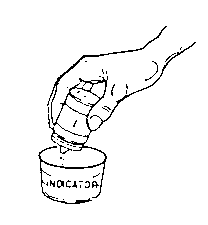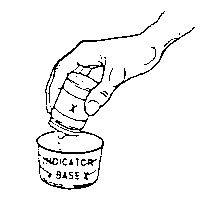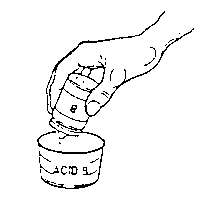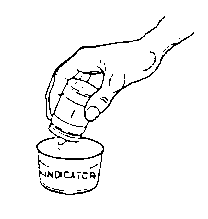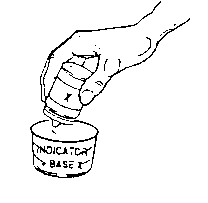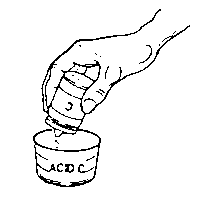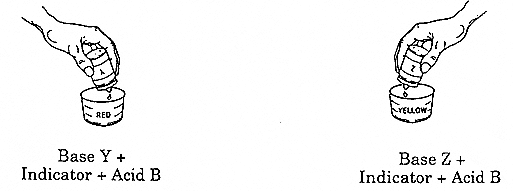 |
 |
|
|
|
|
8th Grade Performance Task Acids and Bases - Form T Every solution is an acid, a base, or neutral. Acids and bases are chemical opposites of each other. Solutions that are neither acids or bases are neutral. Chemists use numbers to indicate the strengths of acids and bases. The numbers go from 1 to 14. Strong acids have low numbers and strong bases have high numbers. Neutral solutions are in the middle. Chemists use a solution called Universal Indicator to identify acids and bases. Universal Indicator changes color when mixed with an acid or base. The Universal Indicator Color Guide shows that Universal Indicator turns red when it is added to a strong acid, it turns purple when it is added to a strong base, and it turns a yellowish-green when it is added to a neutral solution.
All acids in the range of 1 to 4 turn the indicator red. All bases in the range of 11 to 14 turn the indicator purple. Today you will learn how to test if one acid is stronger than another even if they both turn the indicator the same color. PART 1: READING THE SCALE 1a. Which acid is stronger - one that turns Universal Indicator orange or one that turns Universal Indicator yellow? 1b. Which base is stronger - one that turns Universal Indicator blue or one that turns Universal Indicator purple? PART 2: NEUTRALIZING ACIDS AND BASES An eighth grade student named Tony conducted an experiment using the following equipment:
Read Tony's experiment carefully. Then answer the questions clearly and completely. The color of the Universal Indicator can be used to show what happens when an acid and a base are mixed. If you mix the right amounts of an acid and a base you can obtain a neutral solution (yellowish-green color). Because the solution becomes neutral, chemists say acids and bases can neutralize one another. To see how this is done, Tony followed these steps: Step 1: Tony put 7 drops of Indicator into Cup 1. The color was yellowish-green. Step 2: Tony added 7 drops of Base X to the solution in Cup 1. The color turned purple. He wrote the color in Table 1. Step 3: Tony added 1 drop of Acid A, mixed the solution, observed the color, and wrote it in Table 1. He continued adding Acid A, drop by drop, until he had added 8 drops. After each drop he mixed the solution, observed the color, and wrote it in the table. Here is the color he saw after each drop:
Here is the information Tony wrote in the table: Table 1
2a. Look at the sequence of colors in Table 1. Compare it to the Universal Indicator Color Guide on the first page. How did the solution in Cup 1 change as drops of Acid A were added? 2b. How many drops of Acid A did it take to turn the solution yellow? ______________ 2c. Suppose you conducted the same experiment with a stronger acid and recorded the colors in a table. How would the results in this new table be the same or different than those in Table 1? Explain your answer. PART 3: TESTING AND STRENGTH In Part 1 Tony learned a technique for neutralizing a base with an acid. Next he did an experiment to find out WHICH ACID IS STRONGER - ACID B OR ACID C. First, he used Cup 2 and Acid B, as follows: Use Cup 2 and Acid B, as follows:
Use Cup 3 and Acid C, as follows:
Here are the results of Tony's experiment: Table 2
3a. Which acid, B or C, took the most drops to turn the solution orange? ______________________________ 3b. About how many drops of Acid C would it take to turn the solution red? 3c. Explain why you chose this number. PART 4: ANALYZING RESULTS 4a. Fill in the following blank spaces based on the results of Tony's experiment. ______ drops of Base X + ______ drops of Acid B = neutral solution ______ drops of Base X + ______ drops of Acid C = neutral solution 4b. Which acid is stronger - Acid B or Acid C? 4c. How do you know this? 4d. Vinegar is a household acid that can be used in cooking. Most vinegars in the United States are diluted to make a 5% solution, but vinegars in Europe are made into a slightly stronger 6% solution. Chef Andrea uses both types of vinegars in her restaurant. There are three bottles of vinegar on her shelf. One is marked 5% and one is marked 6%. The label has fallen off the third bottle of vinegar. She wants to know if the third bottle is 5% or 6% vinegar. How could she use the equipment Tony used to figure out the strength of the vinegar in the third bottle?
4e. Sally has a bottle of Base Y and a bottle of Base Z. To find out which base is stronger:
4f. How do you know this? |

